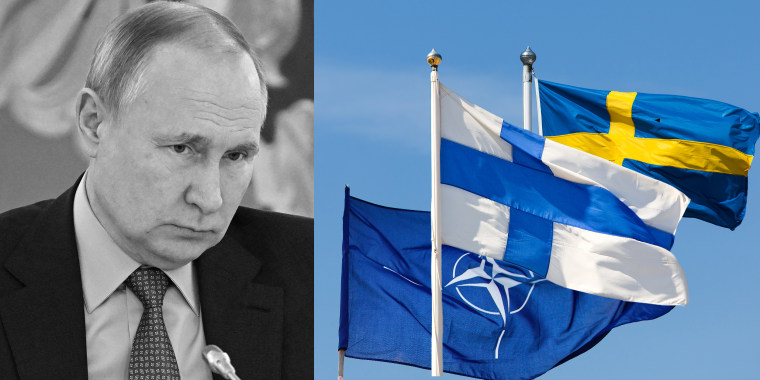In a major announcement, Finland’s prime minister and president on Thursday called for their country to apply for NATO membership “without delay.” The move will require approval from Finland’s Parliament, but The Associated Press predicted it is “all but certain” that the Nordic nation will soon apply to join the Western military alliance. And its neighbor to the west, Sweden, is expected to make the same move next week.
Russian President Vladimir Putin has got to be feeling very, very bad about all this. He called for an end to NATO expansion before he invaded Ukraine and he expected his military operation to expand Russian power in Europe. But his war has achieved the opposite reality: NATO appears to be growing stronger by the day, and Russia’s capacity to project power in Europe is worse than before the war began.
Support for joining NATO in Finland skyrocketed after Russia’s invasion of Ukraine.
Finland and Sweden do already have a relationship with NATO: They conduct joint military exercises and share intelligence with the alliance. But they’ve never been members.
Finland shares an 800-mile border with Russia and has made a point of keeping relatively friendly relations with Moscow since the mid-20th century as a security policy to head off the possibility of a Soviet or Russian invasion. But Russia’s recent behavior has shaken Finland’s faith in that security paradigm. Support for joining NATO in Finland skyrocketed after Russia’s invasion of Ukraine — shooting up from a norm of 20 to 30 percent in recent years to 70 percent. Now many Finnish political leaders are gunning for their country to enter NATO as rapidly as possible.
Sweden is also undergoing a radical shift. It wasn’t involved in either world war, it was neutral during the Cold War, and its posture until recently has been one of military nonalignment. But it too has been rattled by Moscow’s aggressive expansionism, and, like in Finland, public support for joining NATO has surged overnight.
As these countries approach formal membership bids, NATO Secretary-General Jens Stoltenberg and Washington have indicated that they’re eager to embrace them as new members (although there are questions about whether Turkey will try to block their entry). They aren’t large countries, population-wise, but they’re affluent and have sophisticated military technology that would create a net contribution to NATO’s already-massive collective defense capacity. The countries would also add a unique strategic advantage with their geographic locations.
“Having Finland and Sweden in the alliance would arguably make it easier to stabilize the security of the area around the Baltic Sea and to defend NATO members Estonia, Latvia and Lithuania,” a Bloomberg analysis noted. “Those countries are often seen as a potential target for Russian aggression because they have substantial ethnic Russian minorities, and Russian President Vladimir Putin has used protecting such people as a pretext for interventions in Ukraine.”
And, of course, Finland’s border with Russia adds even more NATO-aligned territory to Russia’s border — one of the precise outcomes Russia wanted to eliminate with its invasion of Ukraine. Among other things, Finland’s proximity to Russia would allow for greater surveillance of western Russia, according to Bloomberg.
Russia’s invasion also inspired NATO member Germany, which has the biggest economy in Europe, to re-evaluate its defense outlook. Germany is upgrading its armed forces and will finally be meeting its long-neglected NATO membership commitment of devoting 2 percent of its GDP to defense. (There are questions, however, about Germany’s long-term commitment to this increased defense spending.)
To the extent that Putin thought invading Ukraine could serve as a strategic bulwark against NATO, his plan has been a catastrophic failure. Ukraine’s extraordinary military performance, bolstered by a steady flow of high-tech lethal aid from the West, warded off the swift conquest Moscow had hoped for. Now Russia is fighting in the Donbas region, hoping perhaps to bite off a chunk of the eastern territory to save face after its failure to come even close to fulfilling its initial goal of regime change.
But even if Russia is able to achieve some kind of territorial gain in Donbas — and that is an open question — it’s hard to see how Russia is better off in relation to NATO than before the invasion. After all, Moscow had already been meddling in the Donbas region since 2014, and its backing of separatist forces there had already been effective at helping keep Ukraine out of NATO. (Experts say that part of the reason Ukraine's NATO status was perpetually deferred was because NATO couldn't allow Ukraine in until Russia ceased its meddling in Donbas, otherwise NATO would have had to declare war on Russia the minute Ukraine joined NATO.) In other words, Russia was already doing quite a lot with a light touch; now with a heavier hand, it has made things worse for itself.
NATO has a renewed strategic purpose, appears to be growing in size and financing, and has grown even more attractive to non-NATO countries in Europe concerned about Russia’s unpredictability. At the same time, it could be argued that Russia’s shockingly poor military performance in Ukraine has given it less leverage in its capacity to influence the region over the longer term. Putin’s strategic misstep on Ukraine is looking more devastating by the day.

